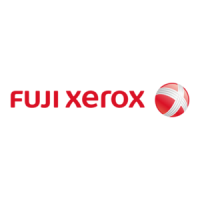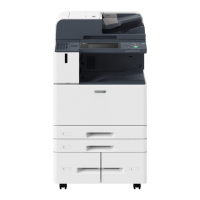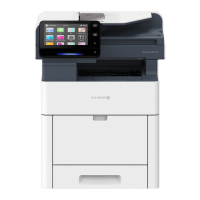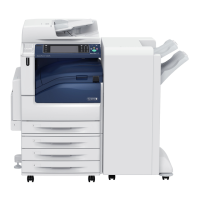Do you have a question about the Fuji Xerox ApeosPort-VII P5021 and is the answer not in the manual?
| Category | Printer |
|---|---|
| Functions | Print, Copy, Scan, Fax |
| Print Resolution | 1200 x 1200 dpi |
| Operating System Compatibility | Windows, macOS, Linux |
| Duplex Printing | Yes |
| Ethernet | 10/100/1000 Base-T |
| Connectivity | Ethernet, USB |
| Paper Size | A4, A5, B5, Legal, Letter |
| Paper Output Capacity | 500 sheets |
| USB | USB 2.0 |
| PDL | PCL6, PostScript 3 |
Introduces the guide and its purpose, assuming user familiarity with computers and networks.
Explains the organization of the guide and conventions used, including symbols and terminology.
Details critical security warnings and recommendations to prevent unauthorized access and data loss.
Identifies and describes the main parts of the device, such as the main unit, control panel, and trays.
Provides a list of graphic symbols used in the manual and their meanings, covering warnings and operational icons.
Offers information about software licenses, including open-source licenses and source code availability.
Explains how to switch the device on and off, and perform initial setup wizard configurations.
Details how to connect the device using Ethernet and USB interfaces for network and computer connectivity.
Guides on configuring wireless LAN settings, including Wi-Fi and Wi-Fi Direct connections for network access.
Provides instructions for setting the IP address and other network information required for network connectivity.
Guides on installing necessary software for Windows OS from the provided disc or website.
Details the procedure for installing software on macOS systems from the provided disc.
Explains how to download and install print drivers for Linux computers from the official website.
Covers Wi-Fi and Wi-Fi Direct connection methods, including setup and configuration steps.
Outlines the necessary settings for configuring email features, including ports, server addresses, and protocols.
Explains how to use Power Saver modes to suppress power consumption and how to enter/exit these modes.
Details the Warmer mode for preventing condensation and how to set it up via system administration.
Describes the Home screen layout, navigation, and basic operations like drag, flick, and tap.
Explains the function of common operation buttons found across various features and services.
Details how to use the on-screen keyboard for entering text and numerals in various settings and applications.
Explains how to authenticate using the touch screen or IC Card Reader to access restricted services.
Guides on customizing the Home screen and features list, including hiding/adding apps and changing their positions.
Provides an overview of CentreWare Internet Services for device status, job history, and settings management via a web browser.
Covers paper recommendations, usable types, and capacity for different trays, including warnings about unacceptable paper.
Summarizes the various print features available, including printing from computers and stored data.
Explains how to print using the print driver, email attachments, and CentreWare Internet Services.
Details features like Sample Set, Delayed Print, Secure Print, and Charge Print for managing stored print jobs.
Covers printing files directly from a USB memory device, including supported formats and removal procedures.
Introduces mobile printing options like AirPrint, Google Cloud Print, and Mopria Print Service.
Explains how to check job status, cancel, promote, and resume jobs.
Guides on how to check the status of active, completed, and pending jobs.
Provides steps to cancel active or pending print jobs through the device interface.
Explains how to prioritize and execute pending jobs preferentially.
Details how to forcibly print jobs that are waiting or paused.
Introduces the section on checking and changing device settings, noting admin authority requirements.
Covers settings for touch-panel display language, keyboard layout, and display language button.
Explains how to check device information, print reports like job history and configuration.
Describes how to view notifications for fault status, replacement periods, and important messages.
Details settings for paper trays, including common settings, type priority, and auto tray switching.
Explains how to check the status of consumables like toner and drum cartridges.
Covers checking serial number, total impressions, copy/print/fax counts, and user account billing.
Outlines procedures for repair requests, software updates, and device checks.
Introduces advanced settings controlled by the system administrator, noting model-specific variations.
Covers system clock, timers, auto clear, audio tones, screen settings, and security warnings.
Details Power Saver modes (Low Power, Sleep), timers, and deactivation settings.
Explains settings for various tones, including job completion, fault tones, and alerts.
Covers screen defaults, language, auto clear display, button color, and brightness settings.
Explains how to set display methods for print reports and job history reports.
Describes how to forcibly print strings like user names and dates as watermarks on documents.
Explains how to print UUIDs for print job identification and tracking.
Details the Image Log Control feature for creating and managing image data of processed documents for security.
Covers browsing and switching available plug-ins, including embedded ones.
Includes settings for auto job promotion, print paper size, data encryption, and FIPS validation.
Covers print settings like memory allocation, job ticket memory, and print order.
Guides on setting up remote access to web applications and configuring the web browser.
Details port settings, network protocols (USB, LPD, IPP, Bonjour, SNMP), and wireless LAN settings.
Introduces the use of certificates for encryption and signature features on the device.
Explains how to check certificate validity for encryption types.
Describes HTTP and IPsec encryption, including SSL/TLS and certificate requirements.
Guides on creating self-signed certificates and importing certificates from other CAs.
Details setting up IPsec communication by arranging certificates and configuring IPsec parameters.
Explains how authentication restricts access, controls service usage, and counts services per user.
Covers selecting user roles and authorization groups for managing access and authority.
Details restricting device access and service usage based on user authentication.
Explains authentication methods like Local Accounts, Remote Accounts, and Smart Card Authentication.
Covers Local, Network, Authentication Server, and Xerox Standard Accounting types.
Shows how services can be restricted and accounted for based on authentication and administration types.
Guides on setting authentication methods, access restrictions, and authorized groups for local accounts.
Details registering local user accounts, setting management authorization, and usage restrictions.
Guides on registering LDAP server information for remote authentication.
Explains how to set up Azure Active Directory for remote authentication.
Covers linking smart cards, setting logout methods, and registering smart card information.
Guides on configuring account administration types, such as local or network accounting.
Explains authenticating login users and changing passwords via the control panel or system administrator.
Lists consumables and periodic replacement parts, with warnings and handling precautions.
Details procedures for cleaning the exterior and interior (LED printheads) of the device.
Guides on manually adjusting paper registration for lead/side alignment to correct image misplacement.
Explains how to adjust the transfer output value manually for each paper type to improve toner transfer.
Introduces troubleshooting procedures for device issues and explains the EP system for service requests.
Lists common device issues like no power, flashing status LED, dark screen, and unable to print, with causes and remedies.
Addresses poor print quality issues such as faint printing, black dots, lines, smudges, and white patches.
Covers problems like data remaining in the printer icon, slow printing, missing document edges, and black lines.
Discusses issues with TCP/IP, CentreWare Internet Services, Email features, and Internet/Intranet connections.
Addresses issues where the "Print from USB" option is not displayed or recognized.
Details troubleshooting for when the device displays no jobs or the feature is unavailable.
Covers issues with selecting printers and problems during printing with AirPrint.
Addresses issues during registration and printing with Google Cloud Print.
Provides procedures for clearing paper jams in various trays, fusing unit, and other locations.
Explains how error messages and codes are displayed and where to find details or seek support.
Refers to the official website for the latest information on optional components.
Details the installation and removal procedures for the optional Wireless LAN Kit.
Guides on installing optional storage devices to prevent data leaks, with important notes on heat and cooling.
Lists technical specifications of the device, including print function, paper size, weight, and CPU.
Defines standard and extended printable areas, including margins and maximum printable dimensions.
Explains printer languages, emulation modes, switching methods, and mode menu screens.
Details emulation print features like Pages per Side, Form Overlay, and Barcodes.
Covers PCL settings related to paper tray, auto size, orientation, and 2-sided printing.
Explains HP-GL/2 emulation settings like paper margin, hard clip area, and auto layout functions.
Details the Auto Layout function, its settings, and how document size and scaling modes determine output.











